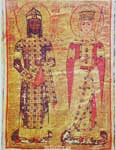|
|
, criticized Manuel for raising taxes: the money thus raised was spent lavishly at the cost of his citizens. The expenses incurred by his expansive foreign policy and generous attitude to money combined with the sumptuous magnificence of his court put a severe strain upon the financial resources of the state.[17] The problems this created were counterbalanced to some extent by his successes, particularly in the Balkans, but in view of the subsequent rapid collapse of the Byzantine Empire, it might have been better to deploy the available resources more carefully, either by building up a strong treasury or by concentrating on less risky ventures. His pro-western policy caused much resentment in the Empire and backfired in the reaction led by Andronicus I Comnenus whose arrival was celebrated by a massacre of the Latins in Constantinople in 1182. These events among others ultimately led to the capturing of the Empire in the Fourth Crusade. Retrospectively, some commentators have criticized some of Manuel's aims as unrealistic, in particular citing the expeditions he sent to Egypt as proof of dreams of grandeur on an unattainable scale. Yet for Manuel, such initiatives had merely been ambitious attempts to take advantage of the circumstances that had presented themselves to him.[18] Legacy Manuel would be remembered in France, Italy and the Crusader states as the most powerful sovereign in the world. A telling reminder of the influence that Manuel held in the Crusader states in particular can still be seen in the church of the Holy Nativity in Bethlehem. In the 1160s the nave was redecorated with mosaics showing the councils of the church. Manuel was one of the patrons of the work. On the south wall, an inscription in Greek reads: "the present work was finished by Ephraim the monk, painter and mosaicist, in the reign of the great emperor Manuel Porphyrogenitos Comnenus and in the time of the great king of Jerusalem, Amalric." That Manuel's name was placed first was a symbolic, public recognition of Manuel's overlordship as leader of the Christian world. Manuel's role as protector of the Orthodox Christians and Christian holy places in general is also evident in his successful attempts to secure rights over the Holy Land. Manuel participated in the building and decorating of many of the basilicas and Greek monasteries in the Holy Land, including the church of the Holy Sepulchre in Jerusalem, where thanks to his efforts the Byzantine clergy were allowed to perform the Greek liturgy each day. All this reinforced his position as overlord of the Crusader states, with his hegemony over Antioch and Jerusalem secured by agreement with Raynald, Prince of Antioch, and Amalric, King of Jerusalem respectively. This, along with his success in the Balkans, must be regarded as one of the greatest achievements of Manuel Comnenus's reign.[19] During his 37 years as emperor, Manuel consistently defeated all attempts by outside powers to attack his Empire: however, in the east, his gains were compromised by the defeat at Myriokephalon in 1176. At his death, the empire was a great power, economically prosperous, secure on its frontiers, but also there were serious problems. Internally, the Byzantine court required a strong leader to hold it together, and after Manuel's death stability was seriously endangered from within. Some of the foreign enemies of the Empire were lurking on the flanks, waiting for a chance to attack, in particular the Turks in Anatolia, whom Manuel had ultimately failed to defeat, and the Normans in Sicily, who had already tried but failed to invade the Empire on several occasions. Even the Venetians, the single most important western ally of Byzantium, were on bad terms with the empire at Manuel's death in 1180. Given this situation, it would have taken a strong Emperor to secure the Empire against the foreign threats it now faced, and to rebuild the depleted Imperial Treasury. Unfortunately for Byzantium, such a man was not forthcoming. Family Manuel had two wives. His first marriage, in 1146, was to Bertha of Sulzbach, a sister-in-law of Conrad III of Germany. She died in 1159. Children: Maria Comnena (1152-1182), wife of Renier of Montferrat. Anna Comnena (1154-1158). Manuel's second marriage was to Maria (renamed Xena upon their marriage), a daughter of Raymond and Constance of Antioch, in 1161. His successor, Alexius II Comnenus, was their son.
Manuel Comenus and his family from a contemporary MS. Footnotes
Sources
Links Manuel coinage: http://www.wildwinds.com/coins/byz/manuel_I/t.html Preceded by: John II Comnenus Retrieved from "http://en.wikipedia.org"
 |
|
|||||||||||||||||


